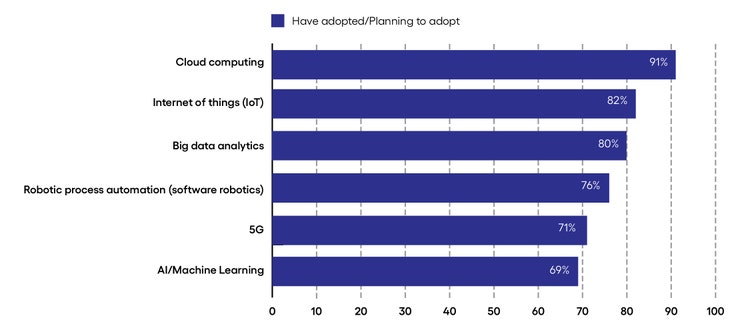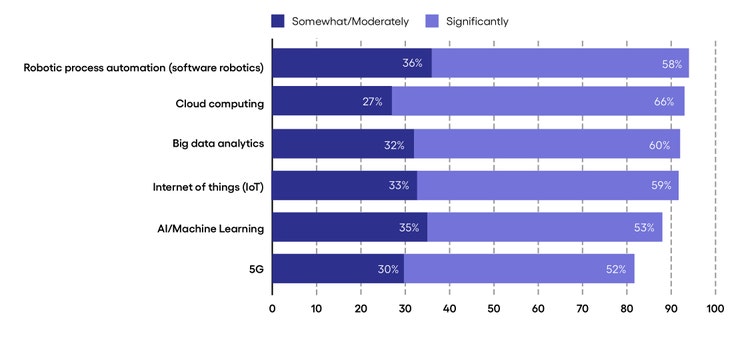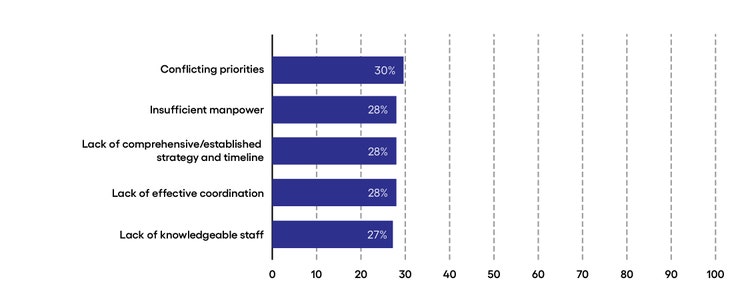
Healthcare companies push ahead with pragmatic transformation roadmaps styles-h2 text-white
<p><span class="medium"><br>July 29, 2022</span></p>
Healthcare companies push ahead with pragmatic transformation roadmaps
<p><b>Healthcare firms aim to drive pragmatic and thoughtful transformation programs that tie technology investment closely to business goals.</b></p>
<p>The healthcare industry has long struggled with effectively leveraging technology to drive innovation. Complex and fragmented, and with a suite of challenges hampering technology adoption, the sector falls behind in digital maturity relative to other industries.</p> <p>However, that was then—before the pandemic. Since then, the sector has met unprecedented demand for services as governments, employers and insurers pushed the industry to do more to meet consumers’ changing medical demands. COVID drove rapid advances in virtual health capabilities and dramatically increased digital adoption rates—while shining a spotlight on the transparency and control consumers have over their healthcare decisions.</p> <p>All this has been set against a backdrop of punishing economic realities that have forced healthcare providers to focus on cost-cutting measures with more intensity than ever before.</p> <p>These trends have altered the dynamics surrounding the sector. Margin pressures and hyper-competitive markets force greater consolidation, accelerating the trend toward vertical integration and further blurring the lines between payers and providers. At the same time, the rapid evolution of the market brings new entrants into play—for example, disruptors carving out niche concierge services that help patients receive timely care. Tech giants are leveraging their strengths in data management for patient prognosis and care, while huge retail players are diversifying into healthcare delivery.</p> <p>Recent Economist Impact research commissioned by Cognizant suggests that while many healthcare companies are developing pragmatic and thoughtful digital strategies, there are clear challenges ahead as talent scarcity, conflicting priorities, and cost pressure keep leaders occupied.</p> <h4>Industrializing virtual health, leveraging data and meeting regulatory changes drive digital investment</h4> <p><em>Respondents were asked what technologies and methodologies their business has already adopted, or is planning to adopt. (Percentage of respondents who advised they have adopted or are planning to adopt each technology)</em><br> </p>

#
<p><span class="small">Response Base: 250 senior Healthcare executives<br> Source: Economist Impact Survey 2022<br> Figure 1</span></p> <h4>What they're good at</h4> <ul> <li><b>Tying spending to business goals.</b> Healthcare is one of the more tactical and pragmatic framers of digital strategy. This is a business historically focused on using technology to drive out costs and increase efficiency—beating many of its cross-industry peers in developing tech strategies that prioritize upgrading old technology, implementing advanced technologies, ensuring interoperability, and improving cybersecurity around patient data. Crucially, tying these investments to business goals is also a strength.<br> <br> </li> <li><b>Using data-intensive tools.</b> Leaders are looking to connect disparate devices and equipment with the Internet of Things and using automation and machine learning to power insights for clinicians, augment diagnostic capabilities, and ensure medical records move seamlessly with patients as they navigate hospitals, care homes, and residences. More experimental efforts are taking place to pull in additional data insights; one example is the use of artificial intelligence (AI)-powered analytics to comb through medical records to identify social determinants of health that can augment medical decision-making and improve outcomes.</li> </ul> <h4>Long way to go</h4> <ul> <li><b>Unique data challenges call for mature strategies.</b> The sector has a major Achilles’ heel: comprehensive data strategies to unite data silos. Healthcare is one of the most tightly regulated industries, and within this context, data—particularly confidential patient data—must be safeguarded. As a result, the data strategies of healthcare companies err on the conservative side. Despite this caution, data-intense technologies to enable personalization, contextualization and engagement sit at the top of the shopping list for many providers.</li> </ul> <h4>The importance of bridging the gap</h4> <ul> <li><b>Adapting to the new operating environment.</b> Emerging from the pandemic, Healthcare organizations face a new world with a new list of challenges, including the need to build resilient systems for tracking, reporting and managing communicable diseases. That said, work begins on modernizing core IT infrastructure to ensure they meet the requirements of new interoperability and transparency regulations as mandated by government policy makers. In the process, organizations are ramping up investment in cybersecurity to face a rapidly evolving landscape of threats—all while examining new capabilities to expand virtual health offerings.</li> </ul> <h4>Gleaning value from tech is critical to Healthcare digital strategies</h4> <p><i>Respondents were asked to what extent the following technologies and methodologies already adopted by their business are delivering strategic value to their operations. (Percent of respondents who selected Somewhat/Moderately, or Significantly)</i><br> </p>

#
<p><span class="small">Response Base: 250 senior Healthcare executives<br> Source: Economist Impact Survey 2022<br> Figure 2</span></p> <h4>What they’re good at</h4> <ul> <li><b>Using digital tech as a differentiator.</b> Consumers are now interacting with healthcare services providers in fundamentally different ways. The pandemic fueled the industrialization of virtual health, changing patient expectations around accessing primary care. New consumer technologies funnel data and decision-making closer to the patient. In this new world, companies with the greatest connectivity or the most intuitive app will be best positioned for differentiation.</li> </ul> <h4>Long way to go</h4> <ul> <li><b>Squeezing out additional value.</b> While Healthcare returns on technology are high compared to those in other sectors, significant opportunity remains. Companies are already working on using technology to reduce costs through such measures as cutting down admin and paperwork while boosting care through consistency and interoperability. Others seek vertical integration to uncover opportunities across the healthcare value chain—with one-stop shops for healthcare driving out redundancy and inefficiency.</li> </ul> <h4>The importance of bridging the gap</h4> <ul> <li><b>Rising to the new economic reality.</b> Caught between changing patient expectations and pressure from stakeholders to drive down costs, leaders must work to intelligently deploy technology. Whether that’s to glean more insights from data to boost productivity or to automate administrative processes, each works to drive out inefficiency. Moreover, there is continuing pressure to transform the sector, so patients receive the very best care at a sustainable price point.</li> </ul> <h4>Talent scarcity and conflicting priorities hold the sector back</h4> <p><i>Respondents were asked what were the most significant challenges for their business when implementing new processes, products, services and technologies in the past year? (Percentage of respondents selecting each challenge. Respondents were allowed to select up to five challenges)</i><br> </p>

#
<p><span class="small">Response Base: 250 senior Healthcare executives<br> Source: Economist Impact Survey 2022<br> Figure 3</span></p> <h4>What they’re good at</h4> <ul> <li><b>Patient-centricity is the North Star.</b> Respondents highlight the highly collaborative nature of the industry. The growing application of retail behaviors manifests as digital strategies that align with the needs of modern consumers. Providers are aligning their strategies toward greater consumer- and patient-centricity—that is, providing simple, consistent and effective experiences.</li> </ul> <h4>Long way to go</h4> <ul> <li><b>Talent scarcity.</b> The sector is wracked by a post-pandemic labor shortage in both clinical and non-clinical roles. Major challenges revealed by respondents include issues around this worker shortage and a lack of knowledgeable staff (named a top-five barrier to healthcare transformation). The solution is to boost the employee experience and relieve burnt-out stakeholders with automation tools that augment critical processes.</li> </ul> <h4>The importance of bridging the gap</h4> <ul> <li><b>Balancing conflicting priorities.</b> Healthcare executives are in an unenviable position. On the one hand, governments and regulators are pushing for sweeping transformation that places much more control in the hands of consumers. On the other, they must cut costs to meet new economic realities. The onslaught of varying, and often conflicting, priorities is stifling decision-making—a challenge noted by many respondents.</li> </ul> <p>As the Economist Impact research commissioned by Cognizant demonstrates, the sector is at a crossroads. The combination of new regulatory environments, complex consumer demands, and an overwhelming need to drive down costs is pushing executives to drive pragmatic and thoughtful transformation programs amidst a consolidating and hyper-competitive market.</p> <p><i>To learn more, visit the <a href="/content/cognizant-dot-com/us/en/insights/modern-business.html" target="_blank" rel="noopener noreferrer">Modern Business</a> section of our website, or <a href="/content/cognizant-dot-com/us/en/about-cognizant/contact-us.html" target="_blank" rel="noopener noreferrer">contact us</a>.</i></p> <p><i>The views and opinions expressed in this report are those of Cognizant and do not necessarily reflect the view and policies of Economist Impact. Data presented is from an Economist Impact executive survey, commissioned by Cognizant, conducted in early 2022.</i></p> <p><i>This article was written by Patricia Birch, SVP, Health Sciences Strategy Leader in Cognizant's Americas Life Sciences practice, Monica Weekes, Vice President and Consulting Practice Lead in Cognizant's Healthcare practice, and Ollie O'Donoghue, Senior Director in Cognizant Research.</i></p>
<p>We’re here to offer you practical and unique solutions to today’s most pressing technology challenges. Across industries and markets, get inspired today for success tomorrow.</p>
